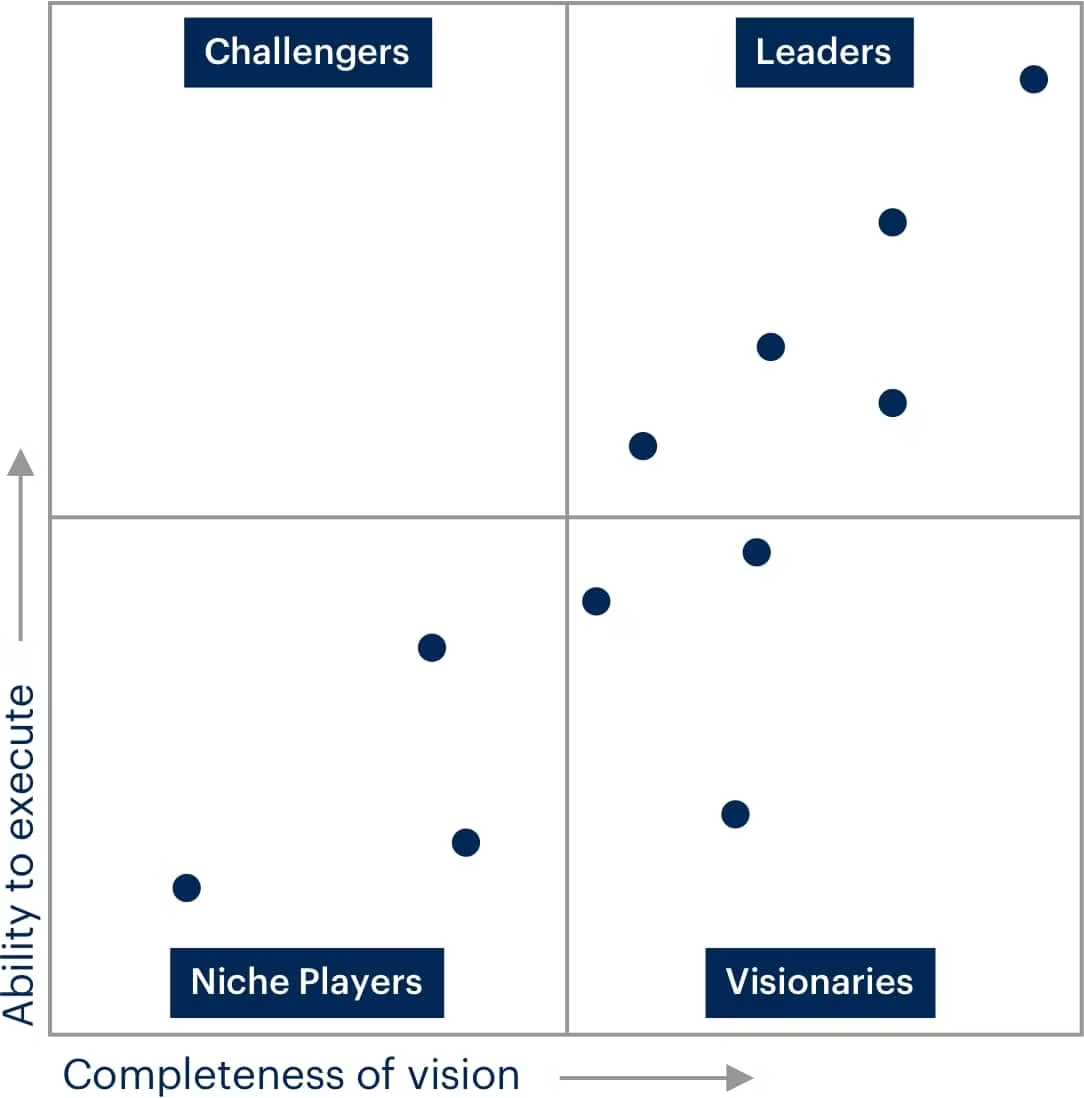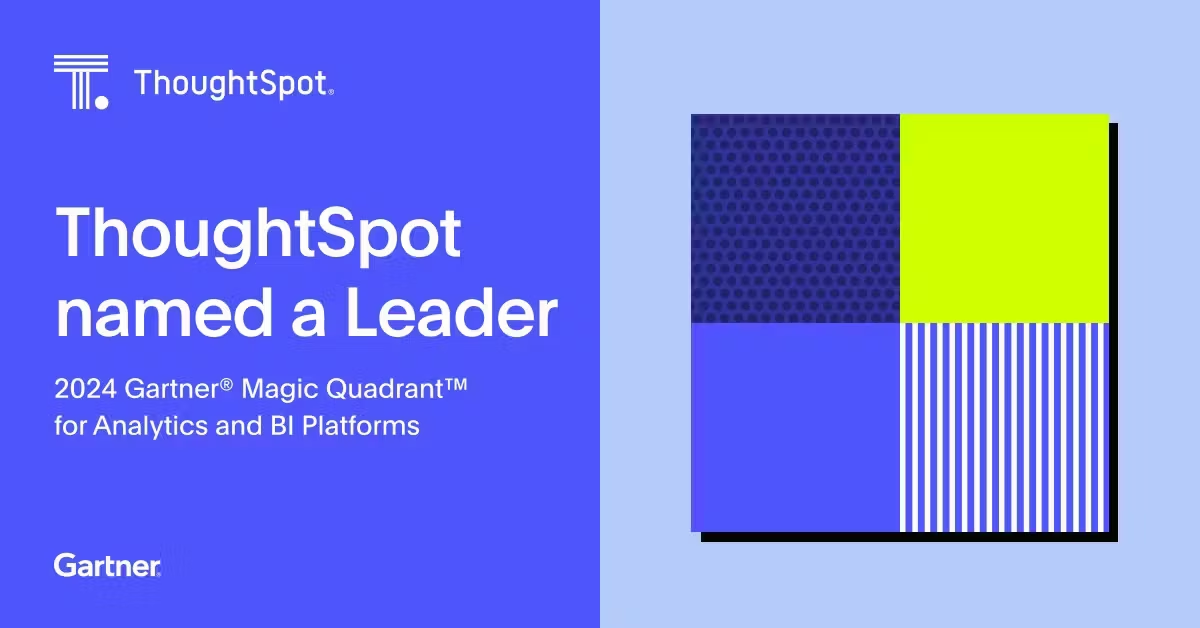Data isn’t just a byproduct of operations—it’s the currency of innovation and strategic decision-making. At the forefront of this data revolution stands Generative AI (GenAI), a groundbreaking technology that is reshaping the analytics and business intelligence (BI) landscape.
The 2024 Gartner® Magic Quadrant™ for Analytics and BI Platforms offers a thorough evaluation of the industry, spotlighting key trends, innovations, and leading vendors. This article is your go-to guide for leveraging the report, providing essential insights into its creation, highlighting key players, exploring the impact of GenAI, and showing you how to use these insights to your advantage.
Table of contents:
The Magic Quadrant is a research methodology and visual representation used by Gartner, to evaluate and position vendors, within a specific market segment, based on their completeness of vision and ability to execute. The quadrant categorizes vendors into four quadrants:

1. Leaders: Vendors excelling in both execution and vision, often setting industry trends.
2. Challengers: Strong executors with less comprehensive visions, poised to compete with Leaders.
3. Visionaries: Forward-thinking vendors with great vision but challenges in execution.
4. Niche Players: Specialists in specific market areas, excelling in those niches but lacking broad vision or execution strength.
In doing so, the Magic Quadrant aims to help you assess vendors within a specific industry, providing third-party validated insights into each vendor's strengths, weaknesses, and strategic position relative to others in the market.
The analytics and BI landscape is undergoing a significant transformation, and that’s reflected in the changes between the 2023 and 2024 Gartner Magic Quadrant BI reports. Here’s a breakdown of what’s changing in the analytics and BI space according to the Gartner Magic Quadrant for BI report:
The rise of generative AI
In 2023, Gartner introduced GenAI as a burgeoning field with immense potential to transform data analytics and BI. The focus was primarily on early adoption, with analytics and BI platforms just beginning to explore how GenAI could enhance data analysis and user interaction. The emphasis was on the experimental integration of AI to augment data modeling and analysis, rather than a fully realized feature set.
By 2024, GenAI has become a fundamental component of analytics and BI platforms. Gartner now highlights the concrete implementation of GenAI to create conversational interfaces and automatically generate insights. GenAI is no longer a future possibility but an integrated feature driving efficiency and usability in data analytics.
Cloud ecosystems and integration
In 2023, analytics and BI platforms prioritized integration with cloud ecosystems and business applications as a crucial selection requirement. The focus was on exploring how platforms could integrate with cloud services and applications, with early-stage AI integration being a key area of interest. The goal was to enhance data analysis and user interaction through these integrations.
By 2024, integration with cloud ecosystems remains essential but has evolved to emphasize governance, interoperability, and AI support. The market is moving towards more seamless and comprehensive cloud solutions that not only offer greater flexibility but also reduce the risk of vendor lock-in. Platforms now integrate more deeply with cloud services, supporting advanced AI functionalities to enhance overall performance.
Enhanced governance and interoperability
Governance and interoperability were important in the 2023 report, but they have since advanced due to the rise of GenAI—and with it, increased concerns about security. Over the past year, many platforms responded to the need for improved usage tracking, data security and sharing controls, and interoperability between different systems and applications.
The 2024 report highlights these changes and seems to factor these capabilities into the vendor’s ability to execute. For example, interoperability is now a key focus in the report. Vendors are measured on how their systems and applications work with other tools within the modern data stack, providing a cohesive analytics experience for all users.
Natural language query (NLQ) and conversational interfaces
In 2023, GenAI was recognized for its potential to enhance user interaction through conversational interfaces and NLP. The focus was on the early adoption of these technologies to make data interaction more intuitive, though they were still in the experimental stages.
By 2024, NLQ and conversational interfaces have become fundamental components of analytics and BI platforms. Users can interact with data using everyday language, significantly enhancing accessibility and usability. This development facilitates more intuitive and efficient data exploration for all users.
Real-time data storytelling and collaboration
Data storytelling combined with AI-augmented visualization was just beginning to emerge in 2023, with a focus on enhancing how insights were presented. Collaboration features were also beginning to integrate with analytics workstreams.
GenAI now facilitates real-time data storytelling and collaboration in 2024. Teams can derive actionable insights, by combining data visualization with narrative techniques. This integration enhances the presentation of insights and supports collaborative decision-making.
Low-code solutions
Low-code solutions have been a part of Gartner's magic quadrant for analytics criteria for embedded analytics. Essentially, it allow developers to integrate features with minimal code, offering composable building blocks like APIs and SDKs.
Today, these solutions are being integrated with GenAI to deliver flexible, modular, and user-friendly interfaces. Now, developers can use these low-code APIs and SDKs to seamlessly embed GenAI-powered analytics, such as ThoughtSpot Embedded, into their own applications. This integration allows for the addition of advanced analytics features with minimal coding effort, enhancing the user experience and functionality of their products.
No-code solutions
No-code solutions, on the other hand, refer to the ability to interact with data without needing to write custom SQL. This has long been a part of many Gartner vendor platforms. For example, ThoughtSpot has been powered by NLQ since its inception. Our no-code analytics experiences allow users to ask questions in plain language and receive insights—without technical expertise.
With the realization of GenAI in 2024, no-code solutions have further advanced, enabling even greater ease of data interaction with increased accuracy. This approach continues to enhance efficiency for data teams by reducing the need for custom SQL code and empowering business users to effortlessly extract actionable insights.
Emphasis on decision-making and business value
In 2023, the emphasis was on automating insights and enhancing data visualization to support decision-making processes. Platforms aimed to deliver valuable insights but were still developing the full potential of integrating AI with decision-making processes.
By 2024, there is a stronger focus on decision-making and business value, with platforms providing enriched contextualized insights that align with user goals and workflows. The integration of AI aims to deliver actionable insights that drive business value and improve decision-making processes by delivering the right insights to the right user at the right time in the place they are already working.
Download the full Gartner Magic Quadrant report to understand the latest advancements in analytics and BI.
As the analytics and BI landscape evolves, several vendors have made significant moves in the 2024 Magic Quadrant. Notably, ThoughtSpot is positioned in the Leaders Quadrant, reflecting its innovation and growing influence. Let’s take a comprehensive look at how vendor placements shifted from 2023 to 2024:
Microsoft: Continued as a Leader
Qlik: Continued as a Leader
Tableau (Salesforce): Continued as a Leader
ThoughtSpot: Moved from Visionary (2023) to Leader (2024)
Oracle: Moved from Visionary (2023) to Leader (2024)
Google: Moved from Challenger (2023) to Leader (2024)
Alibaba Cloud: Continued as a Challenger
Amazon Web Services: Continued as a Challenger
Domo: Continued as a Challenger
Microstrategy: Continued as a Challenger
SAP: Continued as a Visionary
SAS: Continued as a Visionary
Tellius: Continued as a Visionary
Pyramid Analytics: Continued as a Visionary
IBM: Continued as a Visionary
TIBCO: Continued as a Visionary
Zoho: Continued as a Niche Player
Sisense: Moved from Visionary (2023) to Niche Player (2024)
Incorta: Continued as a Niche Player
GoodData: Continued as a Niche Player
To uncover the story behind these shifts and what they mean for your analytics strategy, download the Gartner Magic Quadrant report.

ThoughtSpot shines as a Leader in the 2024 Gartner® Magic Quadrant™ for Analytics and BI Platforms. This recognition reflects our dedication to innovation and customer success in the ever-evolving analytics landscape.
Embracing GenAI: ThoughtSpot integrates GenAI to redefine analytics. Unlike traditional BI tools with manual queries, ThoughtSpot has Spotter, a dedicated AI Analyst that allows users to ask questions in natural language and gain instant answers, democratizing data access and making complex insights accessible to everyone.
User-centric design: Our user-friendly interface simplifies data analysis, making it accessible without extensive training. By focusing on an intuitive user experience, ThoughtSpot ensures valuable insights are easily obtainable.
Innovation and adaptability: At the heart of ThoughtSpot’s strategy is continuous innovation. We integrate cutting-edge technologies, such as machine learning and advanced analytics, and collaborate with cloud leaders to ensure scalability and future readiness.
Customer success and trust: Organizations in retail, finance, manufacturing, media, banking, and healthcare trust ThoughtSpot for accurate, strategic insights. Our platform’s success is validated by customer testimonials highlighting its role in driving data-driven innovation.
Composability and open ecosystem: ThoughtSpot seamlessly integrates with your existing tech stack, providing the flexibility to connect with various tools and platforms and embedding analytics capabilities into any user and application workflow.
As we build on our Leader status, ThoughtSpot will further integrate GenAI technologies, enhance features like Spotter and SpotIQ, and expand ecosystem partnerships. Our goal is to help customers drive meaningful business outcomes and lead in the data-driven economy.
The Gartner Magic Quadrant for BI tools work through a structured research process that evaluates vendors within a specific market segment:
Market analysis: Gartner analysts conduct extensive research and gather data about the market, including trends, customer needs, and vendor capabilities.
Vendor evaluation: Vendors interested in being included in the Magic Quadrant provide detailed information about their products, strategies, customers, and market presence to Gartner.
Criteria selection: Gartner defines specific criteria relevant to the market segment being evaluated. These criteria typically include factors like completeness of vision (innovation, product roadmap, market understanding) and ability to execute (product capabilities, customer experience, financial viability).
Scoring and positioning: Based on the collected data and analysis against the criteria, Gartner assigns scores to each vendor. These scores determine each vendor’s position relative to others evaluated in the market segment.
Publication and use: Gartner publishes the Magic Quadrant report, along with detailed analysis and recommendations. Businesses use this information to evaluate vendors, make purchasing decisions, and understand the competitive landscape within that market segment.
Vendor evaluation: Use the Magic Quadrant to evaluate potential vendors for data-related technologies or services. Focus on vendors positioned in the "Leaders" quadrant for comprehensive solutions and innovative capabilities.
Benchmarking: Compare your current technology providers against those listed in the Magic Quadrant. Assess how your existing solutions stack up in terms of vision and execution compared to market leaders.
Strategic planning: Incorporate insights from the Magic Quadrant into your strategic planning sessions. Identify trends, emerging technologies, and best practices highlighted in the report to shape your data strategy.
Risk mitigation: Mitigate risks associated with vendor selection by using Gartner’s analysis. Avoid vendors positioned lower in the Magic Quadrant unless their specific niche aligns closely with your organization's unique requirements.
Partnerships and alliances: Explore partnership opportunities with vendors positioned well in the Magic Quadrant. Collaborate with leaders to gain access to cutting-edge technologies, enhance your data capabilities, and drive innovation.
Validation: Use the Magic Quadrant as a validation tool when presenting technology investment proposals to senior management or board members. Highlight endorsements from Gartner to build credibility and support for your initiatives.
You can access the full Gartner Magic Quadrant report here, or read our analysis of the report on our blog.








